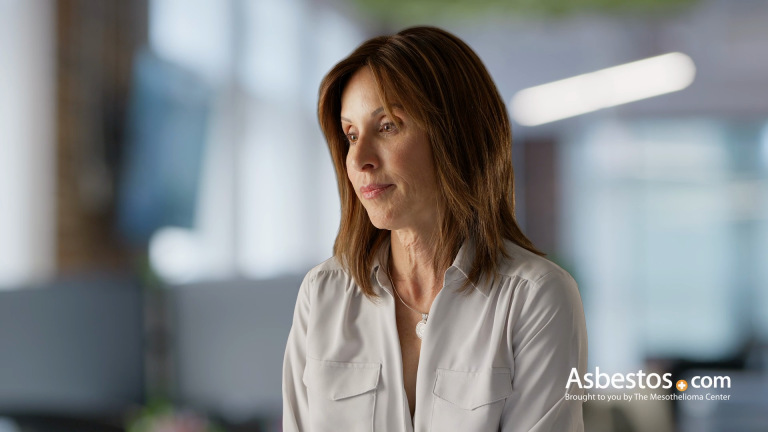Asbestos Exposure
Asbestos is a toxic mineral made of tiny, heat-resistant fibers. When disturbed, it releases dangerous microscopic fibers into the air. Breathing in these fibers can lead to serious diseases, such as mesothelioma, lung cancer and asbestosis.
What Is Asbestos Exposure?
Exposure to asbestos happens when the mineral’s fibers become airborne. Breathing in asbestos fibers can lead to mesothelioma, lung cancer and asbestosis.
Most asbestos exposure happens at work, especially in construction, shipbuilding and in military occupations. But instances of secondhand exposure are common. Living near asbestos mines or factories can also lead to exposure.
The material was widely used in many products and industries. Tiny fibers from car parts, building materials and industrial items can enter the air. People may not know they inhaled asbestos because the fibers are so small.
There is no safe level of asbestos exposure. Even a single heavy exposure is dangerous. Not everyone gets sick, but repeated exposure increases the risk.
Key Facts About Asbestos Exposure
- On-the-job exposure is the most common.
- Construction, military, industrial workers, and first responders are at high risk.
- The construction industry has the highest exposure rate in the U.S.
- Asbestos fibers may take up to 48 to 72 hours to settle in an undisturbed environment.
- It is the No. 1 cause of work-related deaths in the world.
Who Is at Risk of Asbestos Exposure?
Industrial workers faced the most asbestos exposure. Workers in construction and manufacturing also had a high risk. As a result of their loved ones’ jobs, their family members were also at risk of secondhand exposure. Mesothelioma becomes a risk with continued exposure.
Workers at Risk for Asbestos Exposure
- Construction workers
- Family members of asbestos workers
- Firefighters
- Industrial workers
- Mechanics
- Power plant workers
- Shipyard workers
- Veterans
Using cosmetics with talc that contains asbestos also puts people at risk. People can breathe in asbestos from living near contaminated sites. Disasters can also disturb asbestos in buildings.
“I first came in contact with asbestos through the brakes of cars,” mesothelioma survivor Epifanio Figueroa told us. “I also used to be a mechanic for our household. So, I would disassemble cars and come into contact with asbestos.”
Occupational Exposure
Occupational asbestos exposure is the No.1 cause of mesothelioma. Before the bans on asbestos, many industries used it in products and buildings. This put millions of workers in danger. U.S. workers in mining, heavy industry and all construction trades were often exposed to asbestos fibers while on the job.
Auto mechanics and other workers still face risks today. Companies must lower these risks to ensure worker safety. Asbestos removal workers must follow the right abatement steps. If they don’t, there’s a high risk of exposure to airborne asbestos fibers.
Product Exposure

Asbestos companies made many products, from building materials to appliances. They added it to insulation, drywall, ceiling and floor tiles. Offices, schools and public buildings built before the 1980s might still have asbestos. Older military housing and private homes may contain asbestos products.
Asbestos can be found in automotive parts, planes, trains and other machinery. It was used in brakes, clutches and other friction products.
Asbestos-contaminated talc also presents an exposure risk. Baby powder, makeup, and many kids’ products have shown asbestos in recent tests.
Military Service Exposure

Military personnel faced asbestos exposure during the 20th century. All branches of the U.S. armed forces used it for fireproofing to keep them safe. Old asbestos products are still a risk today. Veterans are also at risk of exposure abroad.
Service members on Navy vessels or military vehicles and aircraft from the 1930s to the 1970s were at high risk. Naval shipyard workers were another high-risk group. They were exposed to toxic materials while working on Navy vessels. Even short-term exposure could lead to illness later in life.
Buildings on military bases often used asbestos. Some still pose risks today. Service members with asbestos-related diseases can get VA help for benefits and health care.
“If the majority of a veteran’s exposure was on active-duty matters, then the VA can approve mesothelioma for benefits,” says Aaron Munz, former U.S. Army Captain and director of the Veterans Department at The Mesothelioma Center.
Environmental Exposure
Environmental asbestos exposure happens from industrial operations. Living near an asbestos mine or manufacturing plant can lead to this type of exposure.
Asbestos mine tailings used in roads and driveways is another example. Driving on contaminated materials kicks up asbestos dust. Repeated environmental exposure over time can lead to illness later in life.
Work that releases asbestos fibers threatens nearby communities. Even short exposure has caused disease in those who live near asbestos operations.
This exposure happens when manmade or natural disasters strike. Tornadoes, earthquakes, hurricanes, and fires can harm buildings that have asbestos. First responders and cleanup crews are most at risk.
A manmade example of disaster exposure is the 2001 World Trade Center terrorist attack. The twin towers’ collapse released tons of asbestos into New York City’s air. Researchers now track those exposed. A study showed 70% of emergency responders had respiratory issues in the years after the attack.
Secondary Asbestos Exposure
Secondary exposure can also lead to mesothelioma. Some call it indirect or secondhand exposure. It happens when asbestos workers take fibers home on their clothing, hair or skin. Family members and others in the home can breathe in these fibers. This increases their risk of disease.
Before regulations in the 1980s, there were more cases of secondary exposure. New cases still arise. This is especially true for women and children exposed to asbestos decades ago, as they are now showing symptoms. The highest risk in homes was for women who laundered contaminated clothes.
Mesothelioma survivor Carla Fasolo is one of those people who developed the disease from secondhand exposure. “I’d go down to the boiler room where my dad worked. It was very dusty. There were chunks of gray, fibrous stuff,” Carla told us. “I didn’t know it was asbestos. I’d pick it up and play with it. I helped my mother with the laundry, shaking it, getting the dust off his clothes.

Gain access to top mesothelioma doctors and get help scheduling appointments.
Connect NowTypes of Cancers Caused by Exposure to Asbestos
The most common cancers caused by asbestos exposure are mesothelioma and lung cancer. Asbestos exposure causes about 4% of lung cancer cases. Symptoms appear 20 to 60 years after exposure.
Asbestos-Related Cancers
- Laryngeal cancer: Asbestos exposure, smoking and heavy drinking raise the risk of this cancer.
- Lung cancer: This type of cancer develops in lung tissue. When those with a history of asbestos exposure also smoke, the risk of developing it greatly increases.
- Mesothelioma: This cancer may develop in the lining of the lungs, abdomen, heart or testes. The primary cause is asbestos exposure.
- Ovarian cancer: This is the fifth most common cancer in women. It is linked to talc contaminated with asbestos. Cases of this cancer are increasing from exposure to contaminated baby powder.
Asbestos fibers can travel to various organs and lead to scarring. This leads to DNA damage, which can result in cancer.
Other Diseases Caused by Asbestos Exposure
Some lung diseases from asbestos, such as asbestosis and pleural plaques, are not cancerous, but they can still harm your health and daily life. Those diagnosed have had enough asbestos exposure to be at risk for cancer later in life.
Asbestos-Related Lung Conditions
- Asbestosis
- Atelectasis
- Diffuse pleural thickening
- Pleural effusion
- Pleural plaques
- Pleurisy
Make an appointment with your doctor if you notice signs of asbestos exposure. Difficulty breathing, cough and chest pain are common symptoms of these conditions.
“Any time you move, you cough, you laugh, you bend over, or you get in a car with an active case of pleurisy you feel pain. Anything that rubs up against the pleural sack is very painful.”
How to Protect Yourself from Asbestos Exposure
Safety measures are needed at work to prevent asbestos exposure. Employers need to ensure workplaces are safe from asbestos exposure. If an employer is careless, workers can report it. They must tell the Occupational Safety and Health Administration.
People can also take steps to protect themselves and their families. The U.S. Environmental Protection Agency offers guidelines to prevent exposure.
- Avoid bringing asbestos fibers home from work.
- Avoid disturbing old insulation or tiles.
- Clean contaminated shoes and clothing at the jobsite and take a shower before returning home.
- Don’t disturb asbestos products and do not dry sweep asbestos dust.
- Employers in at-risk industries must provide workers with the facilities to do so.
- Hire professionals for asbestos removal.
- Wear a respirator in high-risk areas.
“Asbestos-related disease is 100% preventable,” Dr. Ken Takahashi told us. He directs the Asbestos Disease Research Institute in Australia. “That fact motivates me. It should motivate all of us. If we stopped using asbestos, by definition, we could stop asbestos disease.”
Common Questions About Asbestos Exposure
- Can one-time exposure to asbestos be dangerous?
-
There is no safe amount of asbestos exposure. Even a single exposure can be harmful at high concentrations. The small fibers that make up asbestos can be breathed in without noticing. These fibers can get stuck in your lungs and may cause health problems later. The chance of developing an illness from just one exposure is low. If you think you were exposed, talk to a doctor so they can monitor your health.
- What should you do if you were exposed to asbestos dust?
-
Anyone exposed to asbestos who has symptoms of mesothelioma should see a doctor. Mesothelioma doctors can also check for misdiagnosis.
- Can I claim any compensation after asbestos exposure?
-
If you have an asbestos-related disease, you might be eligible for compensation. You may qualify to claim mesothelioma compensation from:
If you got sick from asbestos exposure, you should talk to a specialized asbestos lawyer. They can advise you and help you get the compensation you deserve.
- What are the first signs of asbestos exposure?
-
The first signs of asbestos exposure include pain, loss of appetite, fever and excessive sweating. Fatigue, weakness and unexplained weight loss can also be common.










